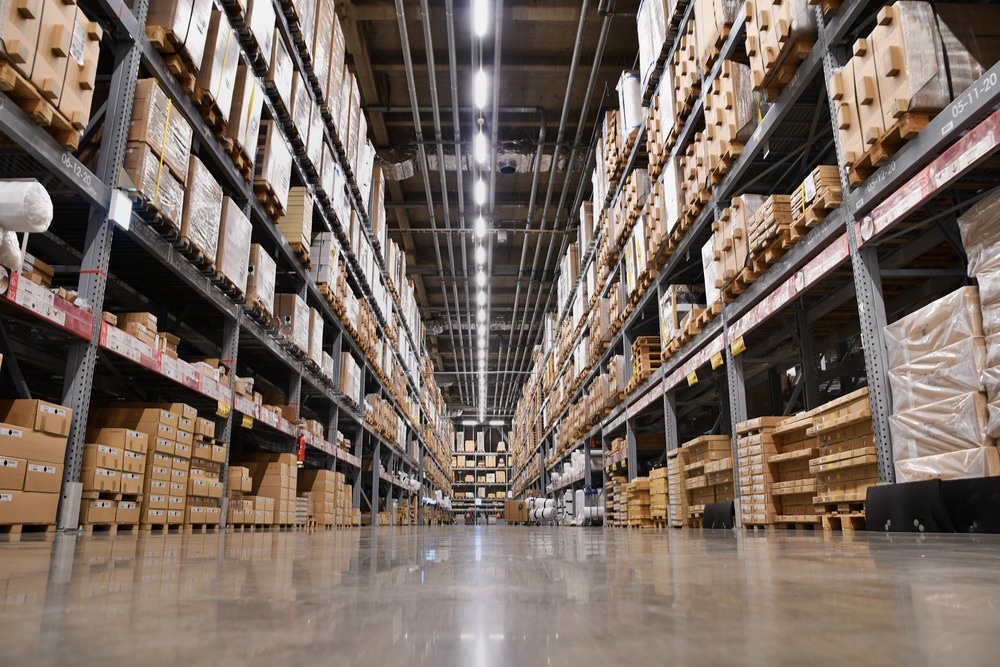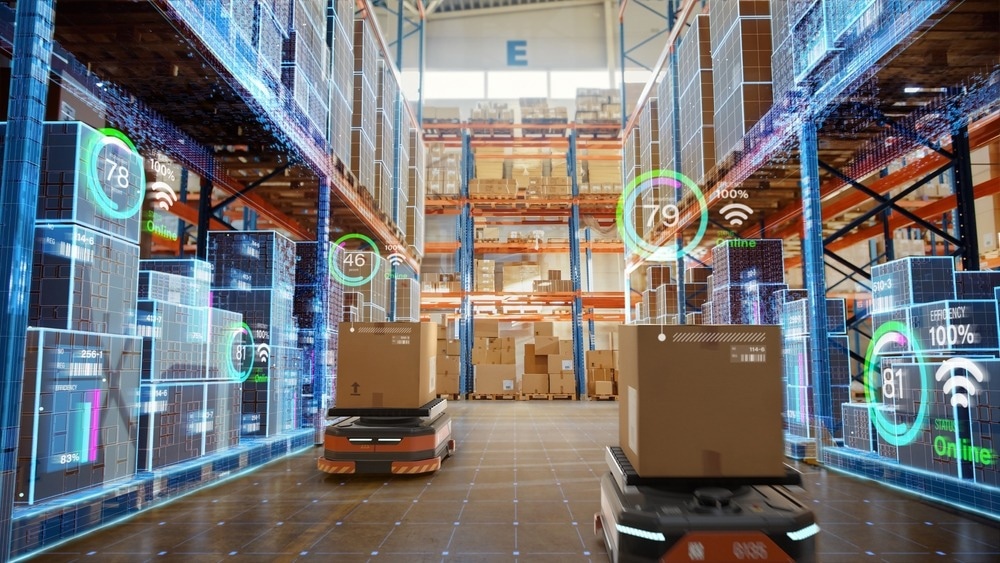Robotic systems have gained prominence in the supply chain, warehousing, and distribution center management circles in recent years, continuing to play an important role in warehouse automation.

Image Credit: dreamnikon/Shutterstock.com
Robotic systems can provide substantial benefits to both the company and its workers, including increased speed and accuracy, flexibility, lower costs, and fewer injuries. They are best suited for repetitive tasks that are dangerous or difficult to perform by humans, including picking and placing items, loading, and unloading trucks, removing damaged products from the line, and product sorting and characterization.
In combination with specialized software, robotic technologies can complete inventory control tasks, data monitoring, and troubleshooting.
Application of Robotics in Goods Management
In the last few decades, human-operated distribution facilities have been the main source of transferring goods to retail outlets and customers. However, after the SARS-CoV-2 (COVID-19) pandemic began, rising customer expectations for quick delivery have rendered this strategy untenable. The recent spike in product demand from customers and the needs of e-commerce have made the survival of big distribution and fulfillment centers difficult without robotic systems.
Owing to the ever-rising customer demand for quick delivery, it has become pertinent for retailers and e-commerce businesses worldwide to find the fastest and most effective means to fulfill online purchases and to reach their supply chain goals.
Robotics were initially deployed in fulfillment operations to reduce human labor by assisting with small repetitive tasks; however, now fulfillment and distribution centers across the globe are transitioning towards full automation.
Common Types of Robotic Systems in Warehouses
Many robotic warehouse systems are being utilized in distribution and fulfillment centers. The employment of these systems depends on the size, capability, productivity, and product being handled by the facility.
The most common types of robots are "Mobile Cart Robots", “Palletizing Robots”, “Automated Guided Vehicles”, and “Collaborative Robots”.
Mobile Cart Robots
Mobile Cart Robots are robotic systems that are great for small spaces, especially in temperature-controlled environments. They are also utilized when there is no conveyor belt movement involved and for moving around lightweight products that do not require any specific order or placement.
Palletizing Robots
Palletizing Robots are used robotic systems responsible for the packing and movement of large quantities of goods within the warehouse. These palletizing robots are synchronized with “Automated Guided Vehicles” which are robotic systems that utilize sensors and artificial intelligence to transport products and goods to various destinations both within and outside of the warehouse.
Collaborative Robots
Collaborative robots are semi-autonomous mobile robots designed to be only guided by humans, not controlled. They can perform tasks assigned collaboratively and dynamically, allowing human workers to focus on specific tasks and leave the rest to the robotic systems.

Image Credit: Gorodenkoff/Shutterstock.com
How Industry Leaders Use Robotic Systems
One of the reasons for Amazon's spectacular ascent during the COVID-19 pandemic is the use of robotics. Amazon would not have been able to scale its company and match the market's strong demand without the assistance of automation.
One of the most significant investments Amazon has made was the purchase of a tiny robotics startup called Kiva Systems in 2012. Currently, at Amazon, more than 200,000 robots work and collaborate with humans to provide same-day delivery.
During the epidemic, Walmart worked quickly to handle the increasing internet demand by utilizing the latest technologies in their operations. They fulfilled customer orders with the assistance of robotic systems.
Walmart has since established a new fulfillment center called a Market Fulfillment Center (MFC), a modular fulfillment center where robot systems, rather than people, retrieve the desired goods.
Furthermore, Walmart is preparing to launch the next addition to their company, allowing customers to pick up their goods from an automated pickup center that will function in combination with MFCs.
Limitations of Robotics in Distribution Centers
The main limitation of robotic systems for companies is that these automated systems are expensive to set up. Most have high upfront costs, so companies often deliberate over whether they will see a return on their investment if they employ robotic technologies.
Another limitation is that remote handling systems are not suited to handle live products. In most cases, human workers must enter the warehouse and retrieve the live products for delivery.
It is also worth mentioning that robotic systems often cannot navigate the entire warehouse.
Commonly, robots can become stuck due to an obstacle or in a tight corner, which forces human workers to step in and finish the job.
Most robotic systems do not always work well in noisy environments or when there are many people around. The sensors used by robotic systems can be easily confused by bright lights, loud noises, and other disruptions.
Yet, even with these limitations, the overall benefits of robotic systems are far greater than the limitations, increasing the efficiency and, in turn, the revenue generated by the distribution and fulfillment centers.
References and Further Reading
Bowman, R. (2022) Watch The Real Role of Robots in Fulfillment Centers. Supply Chain Brain. Available at: https://www.supplychainbrain.com/articles/34909-watch-the-real-role-of-robots-in-fulfillment-centers
Ibbotson, M. (2018). Associates and Alphabot Team Up to Make Walmart’s Popular Grocery Pickup Service Even Better. Walmart (Online). Available at: https://corporate.walmart.com/newsroom/2018/08/03/associates-and-alphabot-team-up-to-make-walmarts-popular-grocery-pickup-service-even-better
HAIROBOTICS (2022). HAIPICK System Boosts Micro-fulfillment Centers in Europe for Faster Online Orders. HaiRobotics. Available at: https://www.hairobotics.com/blog/micro-fulfillment-centers
Simon, M. (2019). Inside the Amazon Warehouse Where Humans and Machines Become One. Wired. Available at: https://www.wired.com/story/amazon-warehouse-robots/
Systems, 6. R. (2022). What is warehouse robotics?. 6River. Available at: https://6river.com/what-is-warehouse-robotics/
Disclaimer: The views expressed here are those of the author expressed in their private capacity and do not necessarily represent the views of AZoM.com Limited T/A AZoNetwork the owner and operator of this website. This disclaimer forms part of the Terms and conditions of use of this website.